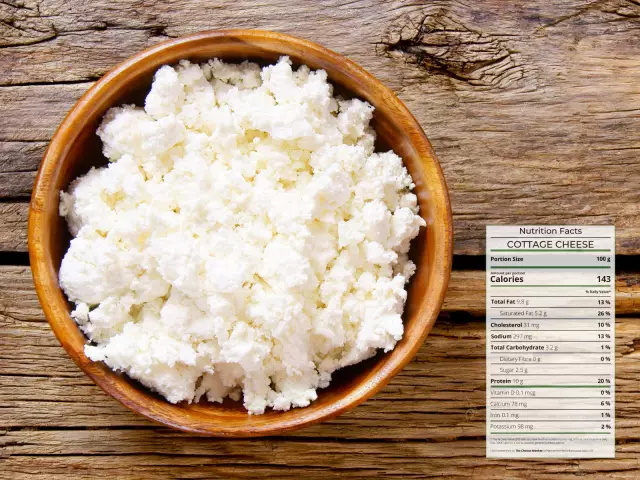- Author Rachel Wainwright [email protected].
- Public 2023-12-15 07:39.
- Last modified 2025-11-02 20:14.
Calorie cheese
The calorie content of cheese depends on its type and variety, but usually a natural product is well absorbed by the body and is suitable for a non-strict diet.
Composition and useful properties of cheeses

Natural cheese contains a large amount of proteins, amino acids and fatty acids. Cheese proteins are well absorbed by the body and are sources of energy. The composition of cheeses includes vitamins A, B, calcium and various trace elements.
Cheese is suitable for the diet of people involved in active sports. Useful varieties of cheese should be consumed after illness, to restore immunity, strengthen the musculoskeletal system of children, adolescents and the elderly.
By the calorie content of cheese, you can determine its useful properties and energy value. Hard types of cheese improve digestion, regulate metabolism and enrich the body with animal fats. Regular consumption of cheese can increase mental alertness and reduce the likelihood of fatigue and exhaustion.
Certain types of cheese are suitable for fitness meals and are recommended as the main ingredient in a healthy menu.
Roquefort cheese is an exquisite French cheese made from sheep's milk. Penicillium fungus is added to the cheese mass to add a piquant taste and form small veins in the product. The calorie content of Roquefort cheese is 332 kcal and can be used for making diet salads, casseroles and side dishes.
The Italian cheese Gorgonzola, which is a semi-hard variety, is famous for its taste. The cheese has a strong aroma and specific taste. Gorgonzola has a low fat content, and the calorie content of cheese is 310 kcal.
To maintain physical fitness and improve digestion, Camembert cheese is used in France, which contains 290 kcal, 20 g of protein and 22 g of fat. And also in Western European cuisine, the original Brie cheese with a nutty flavor is common. 100 g of Brie cheese contains 22 g of fat and 20 g of protein, and the calorie content of the cheese is 289 kcal.
The Mediterranean diet includes soft feta cheese, which is made from sheep's milk. It contains 24 g of fat and 17 g of protein, and the total calorie content of cheese is 289 kcal.
Calorie content of cheese of various varieties
The most common hard cheese is the high-calorie Dutch cheese, which has a characteristic flavor, pleasant aroma and is suitable for fitness meals. Mature Holland cheese has a nutty flavor and is well suited for desserts, casseroles, salads and sauces. The calorie content of Dutch cheese is 352 kcal, and it also contains 28% fat and 25% protein.
English hard varieties include Cheddar cheese with a sour taste that ripens within 100-150 days. The calorie content of cheese is 392 kcal, and it also contains 23 g of protein and 32 g of fat. In terms of taste, Cheddar cheese is close to the varieties Romadur, Munster, Tilsiter and Limburgsky cheese.
In Italy and many European countries, Parmesan is considered the main cheese, which has several varieties that differ in taste and degree of fat content. Parmesan is used in grated form to prepare various dishes. As part of the dietary menu, Parmesan cheese can be sprinkled on salads, soups, pizza, casseroles, meat, pasta and desserts. The calorie content of cheese is 396 kcal, and it also has 32 g of fat and 27 g of protein.

For the preparation of pizza and various pastries, Mozzarella cheese is used, which is made from the milk of buffaloes and cows. Classic European Mozzarella contains 24 g of fat and 18 g of protein. The calorie content of cheese is 240 kcal, which allows it to be used for a diet.
The diet for weight loss often includes feta cheese and Russian cheese. Cheese has a low calorie and fat content, so it can be consumed both separately and with vegetables. The calorie content of Russian cheese is 360 kcal, and it contains 25 g of protein and 29 g of fat. High-calorie Russian cheese can be consumed in small quantities to maintain the body's energy.
Low-fat, low-calorie Adyghe cheese is a variety that consists of pasteurized milk, whey and salt. This cheese contains 18 g of proteins and 16 g of fat. The calorie content of Adyghe cheese is 228 kcal.
The common hard varieties include low-calorie sausage cheese, for the preparation of 1 kg of which 5-8 liters of milk are spent. This cheese is rich in vitamins A, B2, B3, B12 and PP, as well as calcium, magnesium, sodium, phosphorus, zinc and potassium. The calorie content of sausage cheese is 270 kcal.
The most easily digestible and has a positive effect on digestion is the medium-calorie Maasdam cheese. This cheese contains vitamins A and B, minerals, lysine, tryptophan and methionine. The calorie content of Maasdam cheese is 350 kcal, and it also contains 23 g of proteins and 26 g of fat.
Found a mistake in the text? Select it and press Ctrl + Enter.






